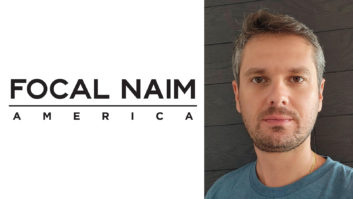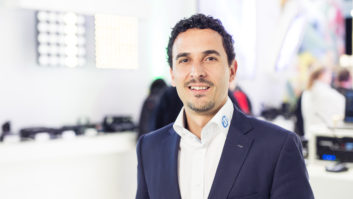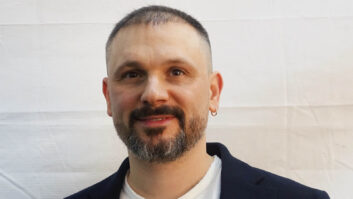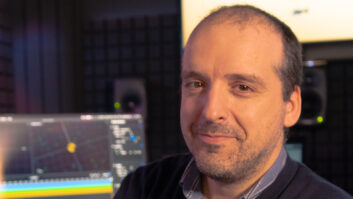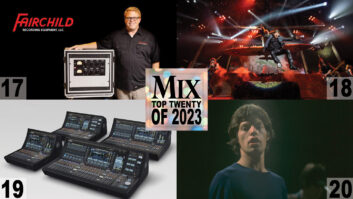With hindsight, it seems almost inevitable that Tom Sumner, president of Yamaha Corp. of America, would forge a career in the pro audio industry. Except for a brief detour, that’s exactly what happened.
Sumner has had a passion for audio and music since his school days. “I played guitar in a number of bands from high school until after college, and I love playing to this day,” he says. Even before that, while in junior high, he built home stereo speakers, selling them locally. In his late teens, he says, “I created and ran my own live sound company, building some of my own speaker cabinets and deploying P.A. equipment that I was using with bands.”
Then came that detour, when he went to work at Macy’s after graduating college: “I managed a retail floor and served as a buyer.” Later, working in various music stores, where he gave lessons and sold keyboards, P.A. systems and guitars, he fell in love with the Yamaha brand, he says. “At one point, our Yamaha rep asked, ‘Would you like to come work for Yamaha?’ and I jumped at the opportunity. My Macy’s experience gave me a strong foundation for success at Yamaha, which I joined in 1988 as a sales rep.”
Three-plus decades later, he says, “I directly lead all our U.S. operations, including sales and marketing, artist relations, operations and our U.S.-based product development. My background has ultimately led me to become a hands-on leader, deeply involved in our many processes and focused on personally encouraging everyone at Yamaha to find their own strength and passion.”
With such a lengthy tenure in the industry, Sumner is well placed to comment on its current state. “Integrators are managing more complex AV system requirements and project parameters. Live sound and audio engineers are dealing with more advanced DSP technology, and more elaborate live shows with extremely high production values,” he says.
“The studio recording process is constantly changing, with a greater reliance on software and post-production processing. Our end-user customers have their own challenges when it comes to implementing new audio system projects, dealing with tighter budgets and shrinking internal resources.”
Last but not least, Sumner observes, consumers are changing their home entertainment behaviors and habits in terms of how they receive and manage their music content, relying more on automation and AI technologies to stay connected.
“These changes aren’t happening in a vacuum. They are all interconnected in some way,” he says. “As all these different customers and their needs change, Yamaha must adapt and change accordingly. By designing our audio solutions to be as connected and intuitive as possible, we’re making it easier for our customers to focus on expanding their creativity and getting the most out of technology.”
Yamaha’s Audioversity professional audio training and education program is one example of the company keeping a finger on the pulse of the industry. “Attendees benefit by gaining a deeper knowledge of the newest professional audio and installed sound products,” he says, “but we also benefit by getting to know our customers and channel partners better, understanding their challenges and their needs, and learning what we can do to be a better manufacturer and industry partner.”
Yamaha maintains R&D staff in the United States, Europe and Japan, with most of the company’s sales, marketing, product management and operations for the United States headquartered in Buena Park, CA. “We conduct R&D at this site and in the field,” he says. “We also rely heavily on our sales teams and all our channel partners—dealers, integrators, installers, consultants—to be our eyes and ears in the field, helping keep us current with what customers need to do their jobs.”
To enable customers to maximize their investment in Yamaha pro audio equipment in the face of constant change, the company has reevaluated the product lifecycle, Sumner reports. “Our goal is to protect customers’ technology investments and help them get as much use out of a device for as long as possible. Through ongoing—and free—firmware upgrades, we allow them to add powerful new capabilities and features, without having to buy a new model or piece of hardware as often. It may cost us some sales in the short term, but we value customer relationships for the long term, doing what’s right for them instead of what’s always better for our top line.”
Related: Sumner Named to Lead Yamaha’s U.S. Arm, March 2, 2018
The state of the economy is always a consideration when it comes to the manufacturing process, product lifecycles or go-to-market strategies, he acknowledges. “However, by continually developing, refining and perfecting our products, and remaining laser-focused on our customers, we’ve maintained a steady course through good economic times and bad.”
Of course, change creates new opportunities, he says, and while live and installed sound continue to be the cornerstones of Yamaha’s pro and commercial audio businesses, “We’re also seeing new markets and applications emerge.” There is more demand for high-quality and immersive sound systems in public spaces, for instance, including retail, hospitality and transport environments. Also, while the house of worship market continues to be strong, a church’s role as the hub of its community may require the mixing console or sound system to also accommodate diverse social and entertainment events without the ministry having to expend time or money on changing out or reconfiguring components. “That’s what Yamaha audio devices are designed to do: make people’s lives easier,” he says.
As for industry-wide technology trends, says Sumner, “We’re certainly seeing a larger trend toward comprehensive audio networking as a requirement for any installed or live sound application. Our strategic partnership and technology collaboration with Audinate has been key to our success in this area.” That relationship began years ago, he says, “and it’s continually evolved and expanded to the point where we’ve integrated some form of Dante audio networking connectivity across all our key product categories,” from power amps to consoles to loudspeakers.
Related: Yamaha Debuts StagePAS 1K Portable P.A. System, June 20, 2019
According to Sumner, Yamaha’s commitment to making innovative products that inspire and allow new and greater forms of creative expression is best summed up in the company’s brand promise: Make Waves. “In the professional audio industry, Make Waves is our commitment to continually innovate and help audio professionals wow their audience every time. Quality and reliability are at the core of every product we make, and we strive to maintain consistency across the broad spectrum of products that we design and market,” he says, from home audio and musical instruments to pro audio.
Sumner says he is proud of the fact that Yamaha makes world-class pro audio products that stand on their own and are even recognized as standards, “But professional customers now need completely integrated audio workflows made up of networked, compatible products. Yamaha is unique in that it can tie all the products audio professionals need into a complete system solution,” including devices from other manufacturers.
“It’s truly one-stop shopping,” he says, “where Yamaha is the end-to-end resource for all things pro audio, offering digital mixing consoles, editing and production software, every level of P.A. system and any type of pro audio accessory under one roof.”
Yamaha Corp. of America • usa.yamaha.com
